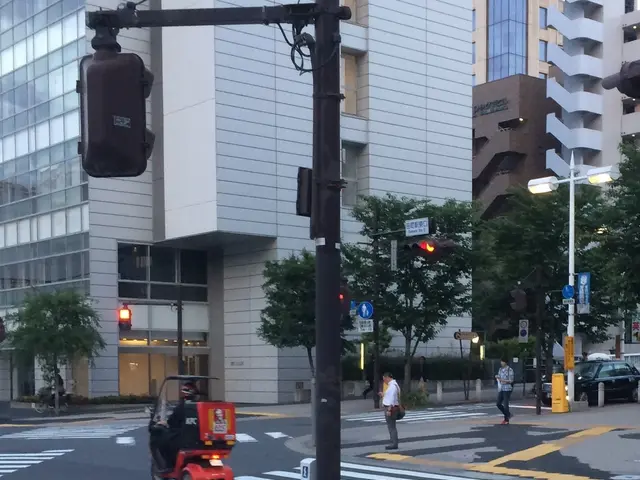Engaging Public Opinion in an Amusing Manner Through Maptionnaire's Democratisation Approach
Revised Article:
*Want a city everyone loves? Here's the secret: listen to the residents.
These days, successful urban planners collaborate with their communities and take feedback seriously. The more people involved, the more representative the results. That's why leaders must appeal to a wide variety of demographics and collect lots of opinions from different neighborhoods.
One way to achieve this goal is by using tools designed for the task.
Map It Out
Enter Maptionnaire, an ingeniously-named citizen engagement platform with online spatial surveys at its core. With this tool, urban planners can place critical questions directly onto a visual map representation of an urban space.
Citizens can see the challenges, proposals, or potential solutions in a geographical context, making it easier to comprehend and provide informed feedback.
While spatial questions (e.g., "Where's your favorite park?") can be answered simply with a click, Maptionnaire also allows for open-text comments. Users can share their thoughts on an area, feature, or urban planning proposal.
This platform collects quantitative and qualitative GIS (geographic information system) data for easy analysis and comparison, decreasing ambiguity and lowering the need for interpretation.
Maptionnaire's founders - Maarit Kahila (CEO) and Anna Broberg (COO) from Mapita - recognized that they didn't need to invent a new wheel. Instead, they recognized that Mampionnaire enhances the traditional consultation toolkit with "powerful spatial functionalities" that resemble, to some extent, methods used in traditional townhall meetings, such as "discussion boards, vision surveys, and voting."
Benefits of Going Digital
Making consultations online brings numerous advantages. First and foremost, more people can access the surveys whenever it's convenient for them, promoting equity and genuine representation.
A Matter of Diversity
In traditional public meetings, you usually hear from the same vocal minority.
We don't want to silence those voices, but we do want to give everyone an equal opportunity to be heard. It's imperfect, but Maptionnaire has increased participation in some cases.
For example, a land management project in Peja, Kosovo saw a higher response rate from middle-aged women than tech-savvy young men, a demographic often overlooked in urban planning processes.
"Within ten days of launching the Maptionnaire survey," their website boasts, "the municipality had received 1,663 responses" - more than double the attendance of the public meetings and a 45% female response rate compared to the in-person rate of just 5%.
More People, Better Planning?
The increased participation can be a double-edged sword. With more voices comes the challenge of managing and interpreting the data effectively.
The new digital age saw urban planners in Finland grappling with a requirement to constantly consult the public. This shift gave people more influence in the decision-making process, but it also led to delays, appeals, and schemes being scrapped altogether. As a result, there were common issues of underutilized land, missed economic opportunities, and lost housing chances.
Transparent community engagement at an early stage can help avoid these disappointments, as highlighted by Maptionnaire's involvement in over 14,000 projects since its inception in 2011.
Participatory Budgeting
While some cities hand over decision-making power to their citizens, Maptionnaire encourages a more gradual approach through its participatory budgeting module. Still, for those seeking a lower-threshold alternative, the platform offers geobudgeting, which presents choices regarding where money can be used, making it simple for citizens to voice their preferences.
Citizen Engagement: Top-Down or Bottom-Up?
One criticism of this digital approach is that it's still a top-down process, with the municipality in control of reaching the city's stakeholders and possessing the power and budget to implement the community's wishes.
To level the playing field, cities can delegate some power to citizens, allowing them to make informed decisions regarding spending. Mappointnaire is designed to facilitate this complex process.
However, it's the citizens' own mindsets that pose the greatest barrier to broader participation.
Not everyone understands the importance of their input, and some insist that planning should be left to professionals. Despite missing the point (city design should reflect the residents' needs, not the other way around), it's a legitimate concern. Democratizing city planning raises philosophical questions about majority rule, priorities, and responsibilities in the planning process.
Mentioning her thoughts on these themes in Mapita's blog, Kahila believes that technology is an essential tool for incorporating various voices over time, not as a quick fix. A single survey or tool is not sufficient to capture the diverse dimensions of urban planning feedback.
Diversity Data Collection
It's crucial to give people multiple avenues for engagement. While Maptionnaire is an effective tool for online surveys, it's not the only option. Other methods, such as traditional public meetings, phone surveys, or in-person discussions, may appeal to individuals who prefer face-to-face interactions.
In fact, the combination of various methods can enhance the overall quality and depth of the data collected, making it easier to analyze and act upon the feedback.
Get the Word Out
While digital tools work well, planners should not rely solely on online platforms to gather opinions. A proactive and targeted approach is essential to engage the desired demographic groups.
Influencers, community leaders, and citizen groups can make effective allies in promoting the survey.
By adopting these strategies and collaborating with Maptionnaire, urban planners can unlock the full potential of their communities and design cities that cater to everyone's needs and aspirations.*
Enrichment Data:- Engaging with Maptionnaire can significantly increase community participation in urban planning consultations. This tool allows users to share their preferences and concerns using spatial tools, resulting in more accurate data collection.- Implementing targeted outreach strategies, such as partnering with community centers, schools, and local organizations, can help reach underrepresented groups and gather more diverse perspectives.- Offering Maptionnaire in multiple languages can include immigrant communities and non-native speakers, increasing the diversity of the feedback received.- Giving citizens access to various feedback mechanisms, like receiving updates on how their input is being used, can encourage continued participation and attract a wider range of contributors.- A combination of engaging events (e.g., public meetings) and digital tools can provide comprehensive and in-depth data that serves as a strong foundation for making informed decisions in urban planning.
The integration of technology, such as Maptionnaire, into general-news and urban planning processes allows for more efficient and diverse citizen engagement in lifestyle matters, thereby ensuring the creation of cities that cater to the needs of various demographics.
This platform, equipped with online spatial surveys, not only caters to a wider range of people due to its digital accessibility but also collects detailed data that can be readily analyzed and compared, thereby lowering ambiguity and the need for manual interpretation.
In light of this, the use of such tools can lead to more equitable and informed city designs, as they provide a platform for open-text comments and encourage participation from underrepresented groups, thus enabling cities to better serve the needs and aspirations of their residents.








